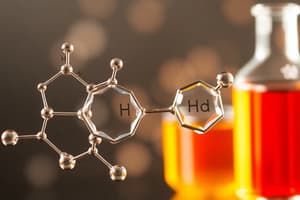Podcast
Questions and Answers
What is the state of aliphatic carboxylic acids with up to nine carbon atoms at room temperature?
What is the state of aliphatic carboxylic acids with up to nine carbon atoms at room temperature?
- Colourless overboiling liquids with pleasant odours
- Colourless solids with pleasant odours
- Wax-like solids with strong odours
- Colourless liquids with unpleasant odours (correct)
Higher carboxylic acids are usually odourless due to their high volatility.
Higher carboxylic acids are usually odourless due to their high volatility.
False (B)
What causes carboxylic acids to have higher boiling points than aldehydes, ketones, and alcohols of comparable molecular masses?
What causes carboxylic acids to have higher boiling points than aldehydes, ketones, and alcohols of comparable molecular masses?
Extensive intermolecular hydrogen bonding
Carboxylic acids with up to four carbon atoms are _____ in water.
Carboxylic acids with up to four carbon atoms are _____ in water.
Match the following carboxylic acids with their solubility in water:
Match the following carboxylic acids with their solubility in water:
Which of the following statements is true regarding the solubility of higher carboxylic acids?
Which of the following statements is true regarding the solubility of higher carboxylic acids?
Most carboxylic acids exist as monomers in the vapor phase.
Most carboxylic acids exist as monomers in the vapor phase.
Flashcards
Physical State of Carboxylic Acids
Physical State of Carboxylic Acids
Carboxylic acids with up to 9 carbon atoms are liquids at room temperature, while those with more carbons are waxy solids.
Boiling Points of Carboxylic Acids
Boiling Points of Carboxylic Acids
Hydrogen bonding between carboxylic acid molecules is stronger than the hydrogen bonding in aldehydes, ketones, and alcohols of similar size, resulting in higher boiling points for carboxylic acids.
Dimerization of Carboxylic Acids
Dimerization of Carboxylic Acids
The strong hydrogen bonds in carboxylic acids persist even in the vapor phase, causing them to form dimers (pairs of molecules) in the gas phase or in solvents that don't form hydrogen bonds.
Solubility of Carboxylic Acids
Solubility of Carboxylic Acids
Signup and view all the flashcards
Solubility of Benzoic Acid
Solubility of Benzoic Acid
Signup and view all the flashcards
Carboxylic Acid Solubility in Organic Solvents
Carboxylic Acid Solubility in Organic Solvents
Signup and view all the flashcards
Odor of Carboxylic Acids
Odor of Carboxylic Acids
Signup and view all the flashcards
Study Notes
Physical Properties of Aliphatic Carboxylic Acids
- Aliphatic carboxylic acids with up to nine carbon atoms are colorless liquids at room temperature, and have unpleasant odors.
- Higher carboxylic acids are waxy solids with low volatility and are practically odorless.
- Carboxylic acids have higher boiling points than comparable aldehydes, ketones, and alcohols due to extensive intermolecular hydrogen bonding.
- This hydrogen bonding persists even in the vapor phase, where many carboxylic acids exist as dimers.
Solubility of Carboxylic Acids
- Short-chain aliphatic carboxylic acids (up to four carbon atoms) are miscible with water due to hydrogen bonding with water molecules.
- Solubility decreases with increasing chain length.
- Higher carboxylic acids are practically insoluble in water due to strong hydrophobic interactions from their hydrocarbon parts.
- Benzoic acid, a simple aromatic carboxylic acid, is nearly insoluble in cold water.
- Carboxylic acids are soluble in less polar organic solvents like benzene, ether, alcohol, and chloroform.
Studying That Suits You
Use AI to generate personalized quizzes and flashcards to suit your learning preferences.




